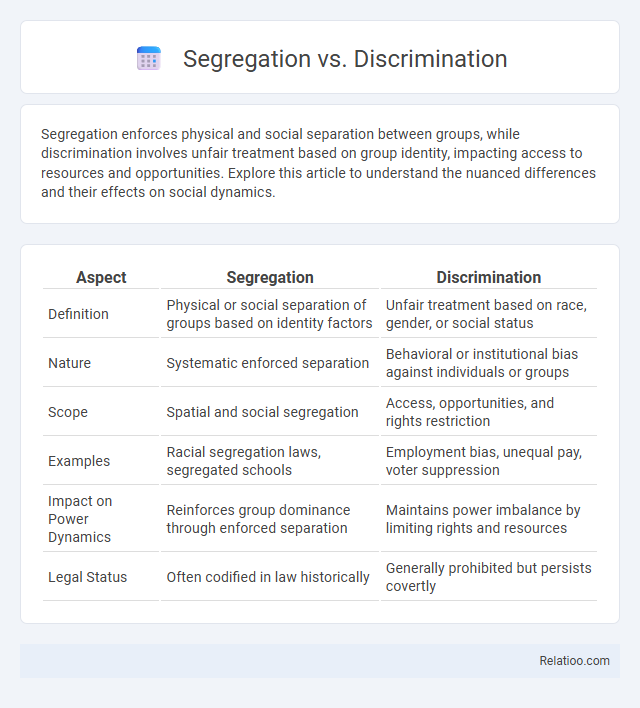Segregation enforces physical and social separation between groups, while discrimination involves unfair treatment based on group identity, impacting access to resources and opportunities. Explore this article to understand the nuanced differences and their effects on social dynamics.
Table of Comparison
| Aspect | Segregation | Discrimination |
|---|---|---|
| Definition | Physical or social separation of groups based on identity factors | Unfair treatment based on race, gender, or social status |
| Nature | Systematic enforced separation | Behavioral or institutional bias against individuals or groups |
| Scope | Spatial and social segregation | Access, opportunities, and rights restriction |
| Examples | Racial segregation laws, segregated schools | Employment bias, unequal pay, voter suppression |
| Impact on Power Dynamics | Reinforces group dominance through enforced separation | Maintains power imbalance by limiting rights and resources |
| Legal Status | Often codified in law historically | Generally prohibited but persists covertly |
Understanding Segregation: Definition and Key Characteristics
Segregation refers to the enforced separation of different groups in daily life, often based on race, ethnicity, or social class, resulting in unequal access to resources and opportunities. Unlike discrimination, which involves prejudiced actions or attitudes against individuals or groups, segregation institutionalizes separation through laws or societal norms. Understanding your role in addressing segregation is vital for fostering inclusive environments that promote equality and social cohesion.
What is Discrimination? A Semantic Overview
Discrimination refers to the unfair or prejudicial treatment of individuals based on characteristics such as race, gender, age, or religion, leading to unequal opportunities and social exclusion. Unlike segregation, which physically separates groups, discrimination manifests through biased actions or policies that deny rights and resources. Understanding discrimination is essential for addressing systemic inequality and promoting social justice across various contexts.
Historical Context: Segregation vs Discrimination
Segregation refers to the enforced separation of different racial or ethnic groups in daily life, most notably seen in Jim Crow laws in the U.S. South, while discrimination involves unfair treatment based on race, gender, or other characteristics across various social settings. Historically, segregation institutionalized racial inequality through laws and policies that physically separated people, whereas discrimination encompassed broader social and economic biases limiting opportunities and rights. Understanding these distinctions helps you recognize the systemic roots of racial injustice and their lasting impact on society.
Legal Frameworks Addressing Segregation and Discrimination
Legal frameworks addressing segregation and discrimination primarily stem from landmark civil rights legislation such as the Civil Rights Act of 1964, which prohibits discrimination based on race, color, religion, sex, or national origin in public accommodations and employment. Court decisions like Brown v. Board of Education dismantled de jure segregation by declaring racial segregation in public schools unconstitutional, reinforcing the legal mandate for equal treatment under the law. Enforcement agencies such as the Equal Employment Opportunity Commission (EEOC) and the Department of Justice's Civil Rights Division play critical roles in investigating and litigating violations to ensure compliance with anti-segregation and anti-discrimination statutes.
Social Impact: Consequences on Communities
Segregation isolates communities by physically separating groups based on race, ethnicity, or socioeconomic status, leading to unequal access to resources like education, healthcare, and employment. Discrimination perpetuates social inequalities through biased treatment and policies that marginalize specific groups, resulting in systemic disadvantages and social tension. Your understanding of these dynamics highlights how segregation and discrimination collectively fracture social cohesion and hinder the development of inclusive, equitable communities.
Case Studies: Real-World Examples of Both Terms
The landmark Brown v. Board of Education case exemplifies segregation by legally ending racial separation in U.S. public schools, while the Civil Rights Act of 1964 addresses discrimination by prohibiting unfair treatment based on race, color, religion, sex, or national origin. South Africa's apartheid system represents a stark example of systemic segregation enforced by law, contrasted with the Indian caste system where discrimination occurs socially despite legal equality. These case studies highlight how segregation physically separates groups, whereas discrimination enforces unequal treatment within social and legal frameworks.
Overlapping Aspects: Similarities and Differences
Segregation, discrimination, and segregation overlap in limiting individuals or groups based on characteristics like race, ethnicity, or social status, but they differ in form and scope. Segregation refers to the physical separation of groups, often enforced by laws or social norms, while discrimination involves unfair treatment or biases against individuals or groups, impacting access to resources and opportunities. Both concepts share roots in systemic inequality, yet discrimination can occur without physical separation, and segregation institutionalizes such separation, reinforcing social hierarchies.
Common Misconceptions and Clarifications
Segregation, discrimination, and separation are often mistakenly used interchangeably, but they denote distinct concepts: segregation refers to the enforced physical or social separation of groups, while discrimination involves unfair treatment based on race, gender, or other characteristics. Common misconceptions include assuming segregation always results from official policies, whereas it can also emerge from societal practices or economic factors. Clarifying these differences is crucial for effective policies promoting equality and social integration.
Modern-Day Manifestations: Are We Still Facing Both?
Modern-day manifestations of segregation and discrimination persist in various forms, such as residential segregation fueled by economic disparities and implicit biases in hiring practices. Systemic discrimination continues to affect marginalized groups through unequal access to education, healthcare, and criminal justice outcomes. While explicit segregation laws have been abolished, de facto segregation and institutional discrimination reveal ongoing challenges in achieving true social equity.
Moving Forward: Solutions for an Inclusive Society
Moving forward, fostering an inclusive society requires dismantling segregation, discrimination, and marginalization by implementing equitable policies and promoting diversity in education, workplaces, and public spaces. Community engagement, anti-bias training, and legal frameworks like the Civil Rights Act play pivotal roles in ensuring equal access and opportunity for all individuals, regardless of race, ethnicity, or socio-economic status. Emphasizing empathy, representation, and systemic reform creates a foundation for sustainable social cohesion and justice.

Infographic: Segregation vs Discrimination
 relatioo.com
relatioo.com